Up to 86% off KN95 masks
- 5-packs to 500-packs
- 3-dimensional filter
- Breathable and lightweight
 Accepts PayPal
Accepts PayPal
The current advice from the World Health Organisation is a well-fitting mask that covers the nose and mouth should be worn when there is community or cluster transmission of the COVID-19. More specifically, it recommends mask use when it's not possible to keep 1 metre away from others both indoors and outdoors, and in indoor settings when there is poor ventilation.
In line with current community outbreaks, each state and territory in Australia has its own mandates for when a mask is required.
Masks are a barrier which prevent droplets from when you breathe or sneeze or cough from reaching others and there are many studies which demonstrate the wearing of masks reduces the spray of droplets from you when worn over the nose and mouth.
Masks are one part of several public health strategies to reduce the risk of transmission of the SARS-CoV-2 virus. Other public health strategies include hand washing, physical distancing (avoiding hand shaking and other close contact), ensuring enclosed spaces are well ventilated, sneezing and coughing into your elbow.
Mask regulations are set by the State or Federal government in Australia and are usually in response to an increase in SARS-CoV-2 circulation and thus an increased risk of virus transmission. You can find out what are the current mask mandates for each state in this guide.
The World Health Organization recommends mask use:
Both WOF and UNICEF recommend that children over the age of 12 wear face masks but children under 5 should not. All Australian states advise that children over the age of 12 must wear masks and follow guidelines for adults, but Victoria has lowered this age to 8.
| Mask type | Reusable | Disposable | Filters air? | Readily available? |
|---|---|---|---|---|
| P2 masks |
|
|
| |
| N95 masks |
|
|
| |
| KN95 masks |
|
|
| |
| Cloth masks |
|
|
|
|
| Surgical mask |
|
|
|
|
Learn more about the different types of face masks available.
 Accepts PayPal
Accepts PayPal Free shipping over $89
Free shipping over $89 Offers Afterpay
Offers Afterpay Accepts Apple Pay
Accepts Apple Pay Accepts PayPal
Accepts PayPal Free shipping over $60
Free shipping over $60 Offers Afterpay
Offers Afterpay Accepts PayPal
Accepts PayPalThere's various types of masks on the market and the best face mask for your needs could vary depending on a variety of factors, like your age, whether you're a medical worker or already sick.
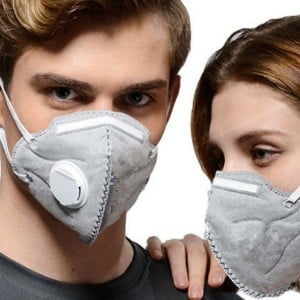
They block out both large and small droplets from reaching your mouth and nose. N95 masks also filter out 95% of particles (including particles as small as 0.3 microns). N95 masks are tight fitting and are ideal for healthcare professionals as they can be fitted properly. These masks shouldn't be used for extended periods.
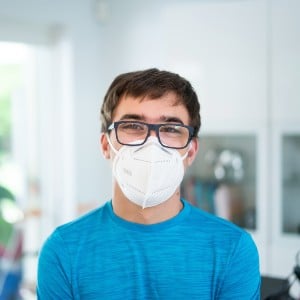
These masks filter 95% of bacteria and are the Chinese standard for the N95 mask. They can block out both small and large droplets, filter air particles and help stop the spread of the virus.
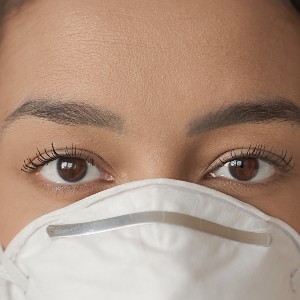
These are Japanese standard masks for protection against dust. They can filter 95% of airborne particles. They offer the same level of protection as P2 masks.
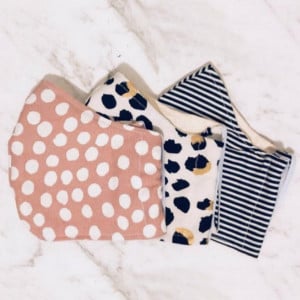
Cloth masks prevent large droplets released by the wearer from reaching the environment. They do not filter bacteria or viruses. Cloth masks minimise the risk of transmission by people who don't have symptoms through talking, coughing or sneezing.

Large droplets released by the individual wearing the mask do not reach the environment. Large droplets and splashes, which contain bacteria or viruses, are also prevented from reaching the wearer. Surgical masks are able to filter 95% of bacteria.
Surgical masks and N95/P2 masks are some of the most popular options for people to buy as PPE.
We've compared the two for fit, the blocking of particles and protection.
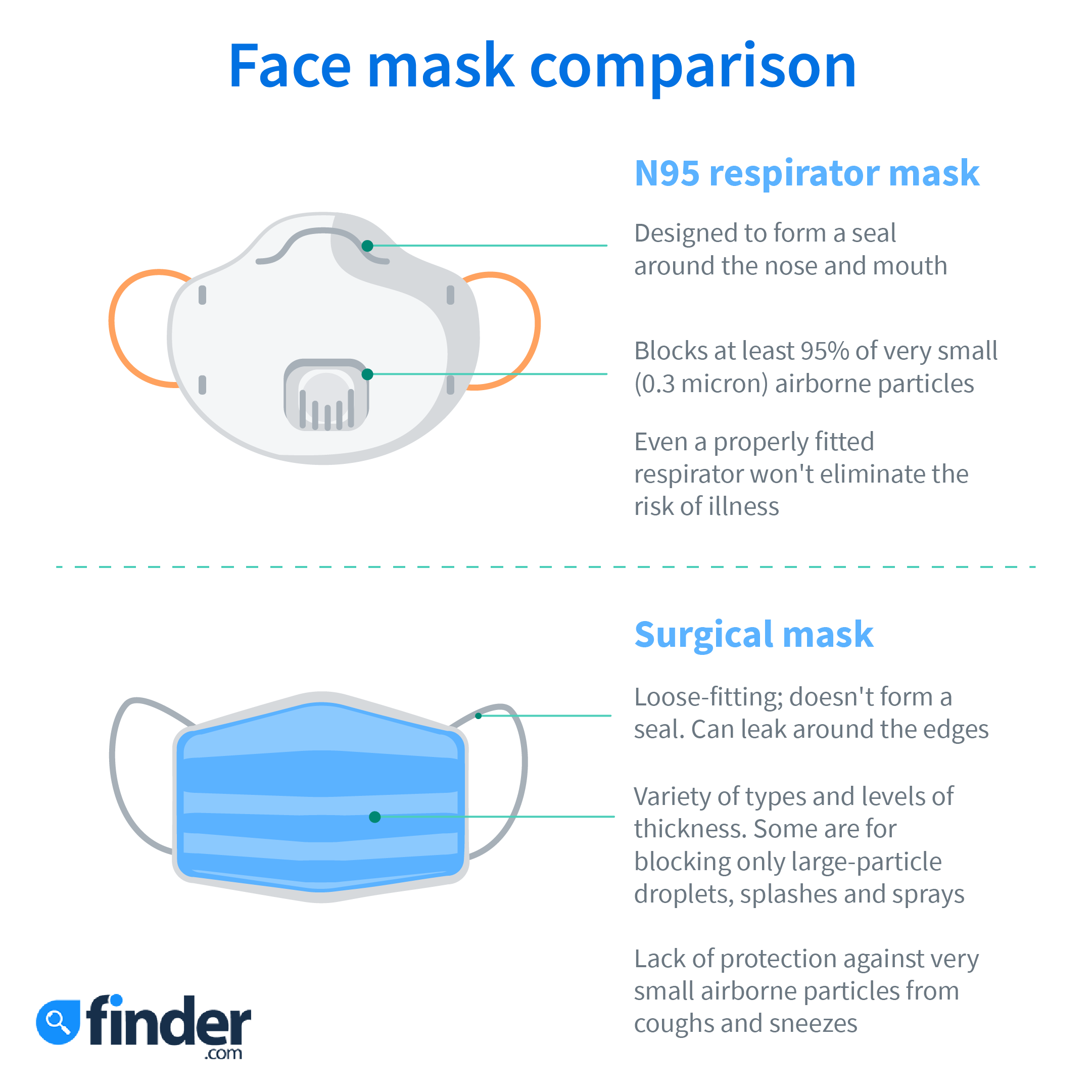
| State or Territory | Requirements | Where to buy a mask by state/territory |
|---|---|---|
| Victoria | Victorians aged 8 years and over are required to wear a mask in all indoor settings as well as on public transport, in a taxi or rideshare, at an airport, visiting a hospital or attending an event with 30,000+ patrons. Exemptions are given if you are receiving beauty services, eating or drinking. A mask must also be worn if you are waiting for COVID-19 test results, have tested positive or are a contact of a known case. | Buy now |
| Australian Capital Territory | Face masks are mandatory in indoor settings (outside your place of residence) for those aged 12 and over. Masks may be removed in certain situations such as while consuming food or drink, doing vigorous excercise and for the proper provision of services. | Buy now |
| New South Wales | Anyone over the age of 12 is required to wear a face mask in indoor areas other than a place of residence. This includes in public transport waiting areas, on public transport, on an airplane and while working at a hospitality venue. Masks can be removed in situations such as while eating or drinking, getting married, working alone in an indoor area, attending a dance class or as a patient in a hospital. On-the-spot fines can be issued for anyone failing to comply. | Buy now |
| Northern Territory | A mask mandate is in place for ages 12 and over when a 1.5 metre distance from others can not be maintained. This includes shopping centres, workplaces, hairdressers, restaurants, pubs or clubs. Masks must also be worn on public transport, in taxis or rideshares and on indoor boat cruises but can be removed while in private residences or while exercising. If you are attending a large public outdoor event, masks are highly recommended. | Buy now |
| Queensland | Queenslanders are required to wear a mask indoors including all workplaces, cinemas, gyms, hospitals, schools, airports, supermarkets and public transport. Masks may be removed in your place of residence or while doing strenuous exercise and a mask inhibits your safety. Children under 12 are exempt and anyone who has a disability or medical condition that affects the use of a mask. | Buy now |
| South Australia | Masks are mandatory in high-risk settings, in indoor public places, on airplanes and passenger transport, while accessing health care and personal care services and for people in quarantine. It's strongly recommended that masks are worn in indoor workplaces and in adult learning environments. | Buy now |
| Tasmania | It is mandatory for Tasmanians to wear a face mask for travel, in public spaces and large outdoor events, as an Essential Traveller and while visiting health and aged care settings. | Buy now |
| Western Australia | Wearing a face mask is mandatory for everyone in Perth, Peel and Rottnest Island in all indoor public places, workplaces, on public transport, in taxis/rideshares, on planes, at the airport and while visiting hospitals and aged care facilities. | Buy now |
Learn more about the current mask mandates across Australia
Depending on your location, different face mask types are more widely used. For example, in the United States and Canada, N95 are common; in Australia and New Zealand, you'll see P2 masks more often; in China, KN95 is the standard. Mask manufacturer 3M, which specialises in filtering facepiece respirator (FFR) masks, offers the following explanation of the main differences between each mask type.
| Certification/Class | N95 | FFP2 | KN95 | P2 | Korea 1st Class | DS |
|---|---|---|---|---|---|---|
Filter performance | ≥ 95% | ≥ 95% | ≥ 95% | ≥ 94% | ≥ 94% | ≥ 95% |
Test agent | NaCl | NaCl and paraffin oil | NaCl | NaCl | NaCl and paraffin oil | NaCl |
Flow rate | 85 L/min | 95 L/min | 85 L/min | 95 L/min | 95 L/min | 85 L/min |
Total inward leakage (TIL) | N/A | ≤ 8% leakage | ≤ 8% leakage | ≤ 8% leakage | ≤ 8% leakage | Inward Leakage measured and included in User Instructions |
Inhalation resistance | ≤ 343 Pa | ≤ 70 Pa (at 30L/min)≤ 240 Pa (at 95 L/min)≤ 500 Pa (clogging) | ≤ 350 Pa | ≤ 70 Pa (at 30L/min)≤ 240 Pa (at 95L/min) | ≤ 70 Pa (at 30L/min)≤ 240 Pa (at 95L/min) | ≤ 70 Pa (w/valve)≤ 50 Pa (no valve) |
Flow rate | 85L/min | Varied – seeabove | 85L/min | Varied – seeabove | Varied – seeabove | 40L/min |
Exhalation resistance | ≤ 245 Pa | ≤ 300 Pa | ≤ 250 Pa | ≤ 120 Pa | ≤ 300 Pa | ≤ 70 Pa (w/valve) ≤ 50 Pa (no valve) |
Flow rate | 85L/min | 160L/min | 85L/min | 85L/min | 160L/min | 40L/min |
Exhalation valve leakage requirement | Leak rate ≤ 30mL/min | N/A | Depressurization to 0 Pa ≥ 20 sec | Leak rate ≤ 30mL/min | Visual inspection after 300L /min for 30 sec | Depressurization to 0 Pa ≥ 15sec |
Force applied | -245 Pa | N/A | -1180 Pa | -250 Pa | N/A | -1,470 Pa |
CO2 clearance requirement | N/A | ≤ 1% | ≤ 1% | ≤ 1% | ≤ 1% | ≤ 1% |
Source: 3M
If P2 or N95 masks are hard to find or out of stock online, consider sewing your own. Guides like this one from The New York Times outline the steps that can have you wearing a cloth mask in an hour or two. If you have a small swatch of fabric about the size of a napkin, shoelaces, scissors, and a needle and thread, you can make a mask without additional supplies.
If there is low community transmission of COVID-19 in the community and no government mandates in place, the wearing of face masks is entirely voluntary. However, if the transmission (or number of cases of COVID-19) increases in your area/State, then mask wearing mandates will be advised by State Health authorities.
The latest advice on face coverings can be accessed on this page and will be guided largely by current transmission/number of cases and COVID-19 infections in each State or local government area. If your area is currently experiencing COVID-19 cases and transmissions, we advise you to find the most up to date advice at the link above.
According to the Centres for Disease Control and Prevention, when worn in a community setting, a face mask is effective in slowing down the spread of the virus. However, it is not a measure that should be taken instead of social distancing, frequent hand cleaning and other preventive measures put in place. A face mask is most effective when it is used in conjunction with preventive measures. Like a flu vaccine, masks help reduce your chance of spreading the virus, but there is no guarantee that you will be safe.
The World Health Organisation recommends the following types of masks for the public:
Disposable medical masks are recommended for:
If you are a healthcare worker, appropriate masks should be provided by your employer.
Cloth masks can be used by the public and have several advantages:
Cloth masks should be made of 2-3 layers of different fabrics (e.g., cotton with high thread count or T-shirt material) which are breathable but able to filter/block droplets from passing through. They should fit comfortably around your nose and mouth and not leave gaps between the mask and the face. You should have at least 3-4 cloth masks so that you can use a new mask every day, adequately wash and dry before reuse, remember once the masks get damp from your breath their effectiveness is reduced. So, you need a supply which will allow you to change your mask frequently as required.
Research done by leading experts in Australia concluded that cloth masks may be used to prevent community spread of many respiratory diseases (including influenza and COVID-19) but are not recommended for use by those working in health or aged care or other areas with high risk of transmission.
As of 11 January 2022, the CDC is considering changing its guidance to recommend the use of N95 or KN95 masks for the public. These types of masks offer a higher level of protection compared to cloth masks and may be more effective against stopping the spread of the highly transmissible Omicron variant.
Disposable masks or surgical masks are not as effective as N95 or P2 masks. The best way to use a disposable mask is to not touch your face, nose or eyes while you have the mask on. Don't touch the mask and use the elastic to remove it. Dispose of the mask after one use and wash your hands after disposing of it. Following these precautionary steps can increase the effectiveness of disposable masks.
Surgical masks aren't designed to be re-used and should be changed regularly. These masks can easily be contaminated and it's recommended to avoid touching the mask while you're wearing it or removing it to talk to someone and then putting it back on.
The WHO recommends you don't wear a mask that's damp, ripped or been within reach of others.
It depends on the type you are using. If you're using a cloth face mask, you should wash it after every use. However, if you are using a disposable mask, it should be disposed of straight after each use.
Some re-usable face masks are only suitable for wearing a designated number of times before they're no longer effective, so if you do purchase a reusable face mask, make sure you check to see how many times you can wash it and still be protected before you need to purchase a new mask.
An Australian study from 2008 found that when worn correctly (closely fitting the face and covering the nose and mouth) masks were more than 80% effective in protection against clinical influenza-like illness. Face masks can slow the spread of airborne viruses and have been proven to protect people from splashes and droplets however, because they usually do not provide a tight seal around your face tiny, droplets can still pass through those gaps, as such the air you inhale, and exhale is largely unfiltered.
There are masks (N95 respirators) which when properly fitted can filter up to 95% of airborne particles, but these masks are heavy duty, form fitted to the face, but uncomfortable and difficult to wear for long periods and need regular maintenance and cleaning to ensure optimal performance.
While not all masks provide the same level of protectiveness, covering your mouth and nose can help prevent moisture from breathing and coughing from traveling too far in the air.
In addition to being much cheaper and more readily available than industry-standard masks, homemade and cloth masks can serve as a constant reminder to avoid touching your face in accordance with governmental and medical advisories.
If you can find a quality mask at an affordable price, it is always the better option. However, if you cannot find any in stock or cannot afford to pay inflated prices, a homemade version could be a good alternative.
Can wearing a face mask reduce your risk of infection? Will a mask protect me from COVID-19?
Masks are not 100% effective in preventing you from getting infected because your eyes are another way that respiratory droplets can enter your body and infect you. Masks are a barrier which prevent droplets from when you breathe or sneeze or cough from reaching others and there are many studies which demonstrate the wearing of masks reduces the spray of droplets from you when worn over the nose and mouth. So, if everyone is wearing a mask, then protection from exposure to respiratory droplets is increased.
Masks are only one aspect of public health strategies to reduce the risk of infection with the SARS-CoV-2 virus (and other respiratory viruses). Frequent hand washing, physical distancing (avoiding hand shaking and other close contact), ensuring enclosed spaces are well ventilated, sneezing and coughing into your elbow, will also reduce the risk of catching COVID-19.
The WHO and Department of Health have various tips for wearing face masks. These include the following:
First, be sure to wash your hands thoroughly (at least 20 seconds with soap/water or alcohol-based sanitiser)
Slip the elastics over your ears, and make sure the front of the mask covers your nose and mouth and sits below your chin.
Squeeze the flexible band (if there is one to fit the bridge of your nose, otherwise just pinch the mask to shape it over the bridge of your nose. Make sure the mask sits snuggly over your face with as few gaps between the mask and your face as possible.
Try as much as possible not to touch the mask while you are wearing it and if it needs readjusting try as much as possible to only touch the sides of your mask. (Wash your hands as above, after your make any readjustments or touch the mask).
Replace your mask immediately if it gets wet.
When you are ready to remove your mask, do not touch the front of the mask – it could be contaminated. Instead, remove it by using the ties around the ears or by pulling the bottom strap over the back of your head, followed by the top strap. Discard the mask and then wash your hands.
No. You should not share your mask with anyone. Even if it is your partner or child and you live in the same household, this is something you should not do. As the virus is spreading so rapidly, extra measures need to be taken and good hygiene practices need to be adopted. Sharing a mask will reduce the effectiveness of this preventative measure.
Generally, infants under 2 years of age should not wear a mask as they are a choking and suffocation risk.
Children under 12 years of age are usually exempted from mask wearing mandates, but they should be encouraged to wear one if practicable.
If it is important for your mouth to be seen (e.g., for lip reading) and for clear communication (especially with people who may have a hearing impairment) you may be exempt from wearing a mask.
If wearing a mask is likely to cause harm psychologically (due to past trauma) or physiologically (such as a medical, mental health or skin condition that would worsen if a mask were worn)
If you are eating/drinking or taking medication you do not need to wear a mask while you are undertaking those activities.
If you are undertaking strenuous exercise such as jogging, running, cycling you do not need to wear a mask while you are undertaking those activities. If you are walking you should wear a mask (even if power walking – you should always have a mask on you during exercising, so that it can be worn when the level of exertion reduces)
NOTE: "If you do not have a medical condition or disability that affects your ability to wear a face mask and are refused entry or service by a shop owner, you are unlikely to meet the requirements of the lawful exception to public health orders – and the refusal of entry or service is unlikely to be discrimination"
Explore how the typical Australian uses their debit card in our detailed guide to debit card statistics.
Learn about Up and Volt in this guide as well as the difference between a digital bank and a neobank.
With convenient access to your funds and a host of flexible features, Bendigo Bank’s Everyday Account can help you manage your day-to-day finances with ease.
Don’t pay unnecessary bank fees, compare financial institutions and learn about the pros and cons of a fee-free bank account.
Multiple methods of access and no conditions to meet make the Simply Access Account a transaction account worth looking into.
IMB gives you a simplified way of taking care of your daily banking needs.
You can save thousands of dollars by maintaining a balance in your 100% offset account.
The best bank account will help you manage your everyday spending with low fees and easy access to your money. Check out our Top Picks curated by experts.
When used wisely, a debit card provides you with great flexibility when it comes to handling your everyday financial needs.
Manage your finances right from your smartphone with a mobile banking app. Review the mobile banking offerings of the major banks and leave a review of your own.